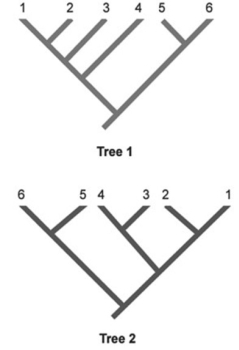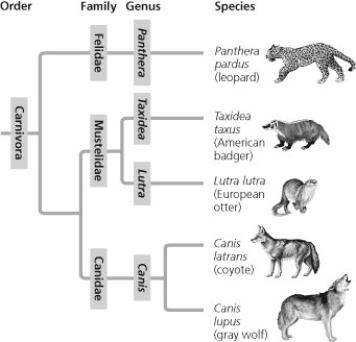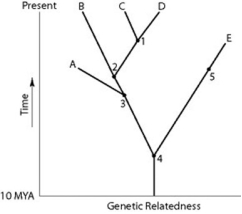A) Plantae
B) Fungi
C) Animalia
D) Protista
F) C) and D)
Correct Answer

verified
Correct Answer
verified
Multiple Choice
Which statement represents the best explanation for the observation that the nuclear DNA of dingoes and domestic dogs has a very high degree of sequence homology? Dogs and dingoes ________.
A) have very similar morphologies
B) belong to the same order
C) are both members of the order Carnivora
D) share a very recent common ancestor
F) A) and C)
Correct Answer

verified
Correct Answer
verified
Multiple Choice
Which of the following would, if it had acted upon a gene, prevent this gene from acting as a reliable molecular clock?
A) neutral mutations
B) genetic drift
C) mutations within introns
D) natural selection
F) A) and B)
Correct Answer

verified
Correct Answer
verified
Multiple Choice
To apply the principle of maximum parsimony to construction of a phylogenetic tree, ________.
A) choose the tree that assumes all evolutionary changes are equally probable
B) choose the tree in which the branch points are based on as many shared derived characters as possible
C) choose the tree that represents the fewest evolutionary changes, either in DNA sequences or morphology
D) choose the tree with the fewest branch points
F) C) and D)
Correct Answer

verified
Correct Answer
verified
Multiple Choice
 In the phylogenetic trees, numbers represent species, and the same species are shown in both trees. Which two species are represented as sister species in Tree 2 but are not shown as sister species in Tree 1?
In the phylogenetic trees, numbers represent species, and the same species are shown in both trees. Which two species are represented as sister species in Tree 2 but are not shown as sister species in Tree 1?
A) 1 and 2
B) 2 and 3
C) 3 and 4
D) 4 and 5
F) B) and C)
Correct Answer

verified
Correct Answer
verified
Multiple Choice
The kingdom Monera was dismantled because of which of the following reasons?
A) Some Monera contained nuclei in their cells.
B) The Monera, as originally constituted, contained both plants and animals.
C) The Monera, as originally constituted, was monophyletic.
D) Some, but not all, of the organisms in Monera contained DNA sequences that were similar to those of eukaryotes.
F) All of the above
Correct Answer

verified
Correct Answer
verified
Multiple Choice
The question refers to the following table, which compares the percent sequence homology of four different parts (two introns and two exons) of a gene that is found in five different eukaryotic species. Each part is numbered to indicate its distance from the promoter (for example, Intron I is the one closest to the promoter) . The data reported for species A were obtained by comparing DNA from one member of species A to another member of species A. % Sequence Homology Which of these four gene parts should allow the construction of the most accurate phylogenetic tree, assuming that this is the only part of the gene that has acted as a reliable molecular clock?
A) Intron I
B) Exon I
C) Intron VI
D) Exon V
F) A) and B)
Correct Answer

verified
Correct Answer
verified
Multiple Choice
The reason that paralogous genes can diverge from each other within the same gene pool, whereas orthologous genes diverge only after gene pools are isolated from each other, is that ________.
A) having multiple copies of genes is essential for the occurrence of sympatric speciation in the wild
B) paralogous genes can occur only in diploid species, thus they are absent from most prokaryotes
C) polyploidy is a necessary precondition for the occurrence of sympatric speciation in the wild
D) having an extra copy of a gene permits modifications to the copy without loss of the original gene product
F) A) and C)
Correct Answer

verified
Correct Answer
verified
Multiple Choice
A large proportion of archaeans are extremophiles, so called because they inhabit extreme environments with high acidity, salinity, and/or temperature. Such environments are thought to have been much more common on primitive Earth. Thus, modern extremophiles survive only in places that their ancestors became adapted to long ago. Which of the following is, consequently, a valid statement about modern extremophiles, assuming that their habitats have remained relatively unchanged?
A) Among themselves, they should share relatively few ancestral traits, especially those that enabled ancestral forms to adapt to extreme conditions.
B) On a phylogenetic tree whose branch lengths are proportional to the amount of genetic change, the branches of the extremophiles should be shorter than the non-extremophilic archaeans.
C) They should contain genes that originated in eukaryotes that are the hosts for numerous species of bacteria.
D) They should currently be undergoing a high level of horizontal gene transfer with non-extremophilic archaeans.
F) None of the above
Correct Answer

verified
Correct Answer
verified
Multiple Choice
Which of the following pairs are the best examples of homologous structures?
A) eyelessness in the Australian mole and eyelessness in the North American mole
B) owl wing and hornet wing
C) bat wing and bird wing
D) bones in the bat wing and bones in the human forelimb
F) B) and C)
Correct Answer

verified
Correct Answer
verified
Multiple Choice
Some molecular data place the giant panda in the bear family (Ursidae) but place the lesser panda in the raccoon family (Procyonidae) . If the molecular data best reflect the evolutionary history of these two groups, then the morphological similarities of these two species is most likely due to ________.
A) the inheritance of acquired characteristics
B) sexual selection
C) possession of analogous (convergent) traits
D) possession of shared primitive characters
F) B) and D)
Correct Answer

verified
Correct Answer
verified
Multiple Choice
The best classification system is that which most closely ________.
A) unites organisms that possess similar morphologies
B) conforms to traditional, Linnaean taxonomic practices
C) reflects evolutionary history
D) reflects the basic separation of prokaryotes from eukaryotes
F) None of the above
Correct Answer

verified
Correct Answer
verified
Multiple Choice
In a comparison of birds and mammals, having four limbs is ________.
A) a shared ancestral character
B) a shared derived character
C) a character useful for distinguishing birds from mammals
D) an example of analogy rather than homology
F) A) and C)
Correct Answer

verified
Correct Answer
verified
Multiple Choice
Some beetles and flies have antler-like structures on their heads, much like male deer. The existence of antlers in beetle, fly, and deer species with strong male-male competition is an example of ________.
A) convergent evolution
B) similarity due to shared ancestry
C) homology
D) parsimony
F) A) and D)
Correct Answer

verified
Correct Answer
verified
Multiple Choice
If you were using cladistics to build a phylogenetic tree of cats, which of the following would be the best outgroup?
A) dingo
B) domestic cat
C) lion
D) leopard
F) B) and C)
Correct Answer

verified
Correct Answer
verified
Multiple Choice
 In the above figure, which similarly inclusive taxon is represented as descending from the same common ancestor as Canidae?
In the above figure, which similarly inclusive taxon is represented as descending from the same common ancestor as Canidae?
A) Felidae
B) Mustelidae
C) Carnivora
D) Lutra
F) B) and D)
Correct Answer

verified
Correct Answer
verified
Multiple Choice
The various taxonomic levels (for example, phyla, genera, classes) of the hierarchical classification system differ from each other on the basis of ________.
A) how widely the organisms assigned to each are distributed throughout the environment
B) their inclusiveness
C) the relative genome sizes of the organisms assigned to each
D) morphological characters that are applicable to all organisms
F) B) and C)
Correct Answer

verified
Correct Answer
verified
Multiple Choice
If organisms A, B, and C belong to the same class but to different orders and if organisms C, D, and E belong to the same order but to different families, which of the following pairs of organisms would be expected to show the greatest degree of structural homology?
A) A and D
B) B and D
C) B and C
D) D and E
F) A) and C)
Correct Answer

verified
Correct Answer
verified
Multiple Choice
 - If the figure above is an accurate depiction of relatedness, then which of the following should be an accurate statement?
- If the figure above is an accurate depiction of relatedness, then which of the following should be an accurate statement?
A) The entire tree is based on minimum parsimony.
B) If all species depicted here make up a taxon, this taxon is paraphyletic.
C) The last common ancestor of species B and C occurred more recently than the last common ancestor of species D and E.
D) Species A is the direct ancestor of both species B and species C.
F) B) and C)
Correct Answer

verified
Correct Answer
verified
Multiple Choice
To apply parsimony to constructing a phylogenetic tree,
A) choose the tree that assumes all evolutionary changes are equally probable.
B) choose the tree in which the branch points are based on as many shared derived characters as possible.
C) choose the tree that represents the fewest evolutionary changes, in either DNA sequences or morphology.
D) choose the tree with the fewest branch points.
F) B) and D)
Correct Answer

verified
Correct Answer
verified
Showing 21 - 40 of 75
Related Exams